THE ENDEAVOUR ARCHIVES: CELEBRATING 30 YEARS OF MORSE ON SCREEN
‘Sit down, Lewis. Glad to see you.’ He continued to write with furious rapidity for two or three minutes. Finally he looked up. ‘Lewis, I’m going to ask you some questions. Think carefully – don’t rush! – and give me some intelligent answers. You’ll have to guess, I know, but do your best.’ Oh hell, thought Lewis.
– Chapter Twelve of Last Bus to Woodstock by Colin Dexter
Interview copyright © Damian Michael Barcroft 2017
Russell Lewis on RIDE
An exclusive ENDEAVOUR interview
by Damian Michael Barcroft
Very special thanks to the best midwife/cheerleader in chief that a fellow could ever wish for.
~
Well, here we all are again. The fourth series is almost, finally!, upon us and if that were not reason enough to raid the Randolph and demand a bottle of their finest champagne, we’re also celebrating the 30th anniversary of Inspector Morse on our television screens. John and Colin, I raise my very first glass to the two of you and simply say thank you – what a legacy! — what a ride!!! Yes, RIDE. Of course, my thanks also to the writer and one of the executive producers of Endeavour, Russell Lewis, who has kindly agreed to submit himself to yet another interrogation – actually our ninth if you can believe such a thing! And, if you’re one of those lovely people who’ve been around since the beginning of these Endeavour interviews (very much appreciated by the way – and if you’re late to the party, welcome – I’m sure you’re equally quite lovely in your own way but what took you so long?), you may also find it hard to believe that there is actually anything new left to discuss.
Well, dear readers, you will be the judge of that but I can assure you, for me at least, there are still so many important questions yet to be asked such as what does Thursday have on his Wednesday sandwich and where the hell is Mrs Bright? Anyway, I’m reminded of the time, some years ago now, when Russ suggested that I begin these interviews with the warning that he tends to wheeze on like an old busted accordion. Should you the jury find him guilty of such a crime – I’ll surely be sharing the same prison cell. However, until such a verdict arrives, we’ll continue with what has now become something of a tradition and take a look back at the films from the previous series while also previewing tonight’s new offering. And, since it’s been thirty years since Inspector Morse first appeared in the corner of our living rooms (we should have asked him to pay rent if only we’d known back then how long he’d stay or at least get the drinks in every once in a while), let’s also ask Russ about some of his favourite episodes.
So, put on your best bib and tucker, join us in raising a glass to the cast and crew (both old and new!) who, for all these years, have nurtured, nursed and nourished Colin Dexter’s legendary and beloved creation – our friend, Endeavour Morse. Happy 30th Anniversary! – here’s to Team Endeavour and you, the Mateys – let’s have some bloody fun…
DAMIAN: Lewis, I’m going to ask you some questions… No, no, seriously now, Russ, how are you?
RUSS: Mustn’t grumble, dear fellow.
DAMIAN: And how are you feeling as we approach the broadcast of ENDEAVOUR IV and the 30th anniversary of INSPECTOR MORSE?
RUSS: The usual blend of apprehension and excitement.
DAMIAN: Like the James Bond franchise (with the possible exception of DIE ANOTHER DAY – invisible Aston Martin indeed!), there’s something to enjoy in every ENDEAVOUR film but those that I would regard as classic or at least what I consider to be some of the very best include: FIRST BUS TO WOODSTOCK (so called “Pilot”), FUGUE (Series 1: Film 2), HOME (S1: F4), NEVERLAND (S2: F4) and CODA (S3: F4). Seen as a whole, series three was quite different in many ways; really rather unconventional particularly in comparison to INSPECTOR MORSE and saw the introduction of an evil twin brother, poisoned applesauce -Hey, now!- and a bloody man-eating tiger on the loose! Any regrets?
RUSS: Well — we always try to provide a bit of something for everyone across the run.
It didn’t feel particularly unconventional to us as we were making it, I don’t think. Things evolve — and should do, otherwise there’s a danger of it becoming stale for the audience, and for those of us involved in making the show. But that said — it still had Endeavour’s DNA hard-wired throughout proceedings.
DAMIAN: In terms of visual effects, what cost Mammoth Screen more money, the tiger or Jenna Coleman’s eyes?
RUSS: Beguiling as they are, I couldn’t speak to Ms.Coleman’s eyes.
DAMIAN: I promise not to tell Mr Timmer but what were you watching in the BBC and ITV battle for Sunday nights last year – POLDARK or VICTORIA?
RUSS: Happily, I was too busy working on Series IV to have to make a choice. My stockpile of shows awaiting a watch grows ever larger. I will binge all of it one day. However, I was heartened to see so many ENDEAVOUR alumni involved in the latter — both in front of and behind the camera.
DAMIAN: Back to the subject of twins, did you happen to see SHERLOCK: THE ABOMINABLE BRIDE which aired last year only a couple of days before RIDE?
RUSS: I did, indeed. Always a delight. I guess what you’re rather diplomatically alluding to is, ‘It’s never twins.’ Except, of course, when it is. Agatha wasn’t above using them. Nor Shakespeare, Dumas, &c.. So, I didn’t feel I was in too poor company.
There were also what the Daily Mirror (was it?) tactfully referred to as ‘two sporting brothers’ knocking around the East End. So… Jack the Hat might have had something to say about ‘It’s never twins.’ Or perhaps, more properly, to give them their dark due, ‘It’s never The Twins.’
I think — originally — our pair started out as twins found in a dodgy orphanage in America, and ‘acquired’ by the magician for the purpose for which they were eventually professionally deployed, but, in the end, it was felt to be another loop of plot that required explanation, and we just simplified it.
The original story was much darker — and touched on a case in which Endeavour had been in another part of the country when still a probationary Police Constable — which would have given the audience a view of Shaun in uniform. In that version, Conrad was a serial killer in a slightly more traditional vein. Trewlove was also introduced in this iteration of the story. But, all of that was kicked into touch in pre-production.
“The finding of this Board is that the tragic events of last December, which led to the shooting of DI Thursday and the arrest of DC Morse, were due solely to a mental breakdown suffered by ACC Clive Deare. We are also of a view that further investigation into other, extraneous, matters would not be in the national interest. To which end, all investigative materials relating to Blenheim Vale Boys’ home are to be sealed for 50 years.”
– RIDE
 DAMIAN: At the end of series two, you left us with Thursday shot and fighting for his life, Endeavour languishing in jail, Jakes still drowning his sorrows in the pub, Monica with the moped peering out of the window searching for her lover, and Win, Joan and Sam waiting anxiously by the telephone. Despite the audience having to wait almost two years to find out what happened next, you decide to open series three, not with the recovery of Thursday or even the release of Endeavour, but rather an expository voiceover and moving the story forward some three months later. What would you say to some fans and members of the audience who may have felt somewhat cheated by the resolution of what was a stunning cliffhanger?
DAMIAN: At the end of series two, you left us with Thursday shot and fighting for his life, Endeavour languishing in jail, Jakes still drowning his sorrows in the pub, Monica with the moped peering out of the window searching for her lover, and Win, Joan and Sam waiting anxiously by the telephone. Despite the audience having to wait almost two years to find out what happened next, you decide to open series three, not with the recovery of Thursday or even the release of Endeavour, but rather an expository voiceover and moving the story forward some three months later. What would you say to some fans and members of the audience who may have felt somewhat cheated by the resolution of what was a stunning cliffhanger?
RUSS: Clearly, one wouldn’t want anyone to feel cheated or short changed. The two year break was not something we anticipated when the cliffhanger was laid down – as I’ve mentioned previously – the World Cup schedule caught us all off guard.
There was a feeling that — with the additional time that had fallen between series — opening with a huge information dump ran the risk of alienating those perhaps tuning in for the first time — and could also confuse both the casual viewer, and even those with some recollection of how things had been left.
If I remember right — the drafts, until quite late into prep., went into greater detail — covering a fruitless search of Blenheim Vale grounds for Big Pete, and the villains who had got away… However, all of it was flashback and viewed through the device of the Board of Inquiry. As we got closer to shooting, and again in the edit, these beats were reduced and thinned down to the salient information required to grasp where Endeavour and Thursday were.
Essentially – the most important cliffhanger was whether Thursday had survived, and that was answered in pretty short order. Again — Social Media was always going to let that particular cat out of the bag. Given Endeavour’s later career, the assumption was that most would understand he MUST have been released from prison.
We could have gone into the aftermath in more detail – shown Bright minding Thursday; Endeavour in chokey, &c., but that could have chewed through most of the first REEL, if not more.
You pays your money, and you takes your choice. We are always up against it trying to squeeze as much meaty goodness into our 89 minute running time — and the new story had to take precedence.
Starting the story three months after events in NEVERLAND was purely down to a shift in our production schedule. We shoot in sequence, and achieving mid-winter in early spring would have been somewhat unfeasible.
DAMIAN: Do some of the issues we’ve just discussed also perhaps highlight the problem that you’re obviously trying to balance ongoing character arcs and development with the well established confines and conventions of detective drama and mystery thriller genres?
RUSS: I don’t particularly think of it as a problem. It’s always a challenge to get the balance right — but the feedback from the audience is that they would like more character development. Fashions change. If you look back to Inspector Morse, and LEWIS (to begin with at least) — the transmission order (perhaps with the exception of DEAD OF JERICHO and the later ‘specials’ that pretty much followed Colin Dexter’s ordering) was decided after production. So they opened and closed with what they felt to be the strongest stories of each series. There was very little, if any, character development. The reset button was pressed at the end of each adventure. Certainly all the feedback we have is that the audience really enjoys and responds to seeing how this set of characters develop and interact.
DAMIAN: Although you have occasionally used very brief flashbacks on the show, the format doesn’t allow you to have, for example, the beginning of RIDE still set in December 1966 in order to facilitate scenes of Thursday in hospital and Endeavour in prison, then move the story forward to the Bixby case in March 1967 does it?
RUSS: No – we could have covered December 1966 with mostly interiors, and then jumped forward in RIDE, but it was an editorial decision to get into the new story almost from the off — and intercut that with fallout from NEVERLAND.
 DAMIAN: Strange tells Endeavour at the fairground that Bright had Thursday under 24-hour armed watch while he was in hospital and never left his side until he was out of the woods. Shame we didn’t get to see it, that would have made a beautiful scene wouldn’t it?
DAMIAN: Strange tells Endeavour at the fairground that Bright had Thursday under 24-hour armed watch while he was in hospital and never left his side until he was out of the woods. Shame we didn’t get to see it, that would have made a beautiful scene wouldn’t it?
RUSS: That would have been one way of doing it. I covered the evolving Thursday/Bright dynamic in a scene in the woods between them, when the body of the clippie was found. However — it was shot as a single unbroken take on day one of the Production Schedule. It contained some pretty soul-searching dialogue from Bright, and some consolation from Thursday. However, we didn’t have the closes of Rog and Anton — and without them we felt the scene lacked the appropriate level of intimacy for the matter under discussion. So, very sadly, it didn’t make the cut.
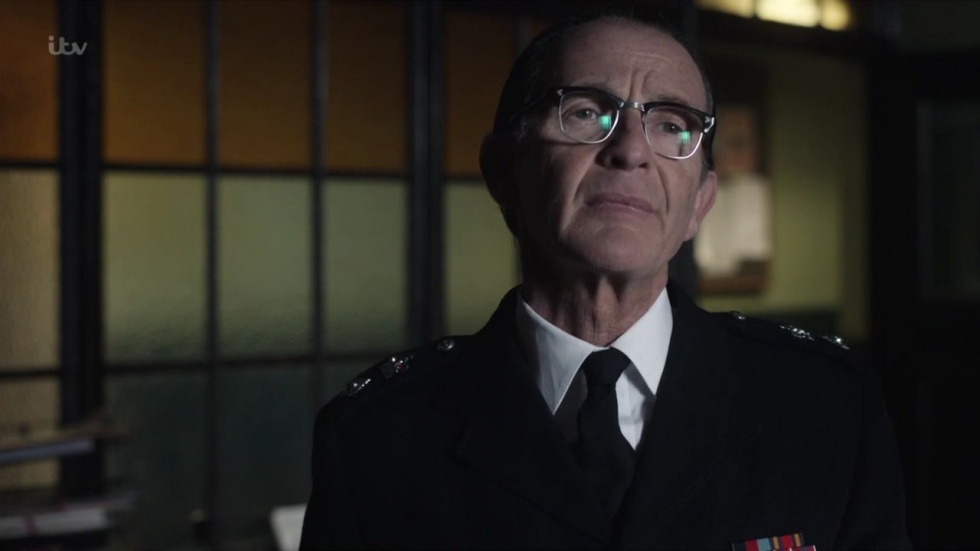
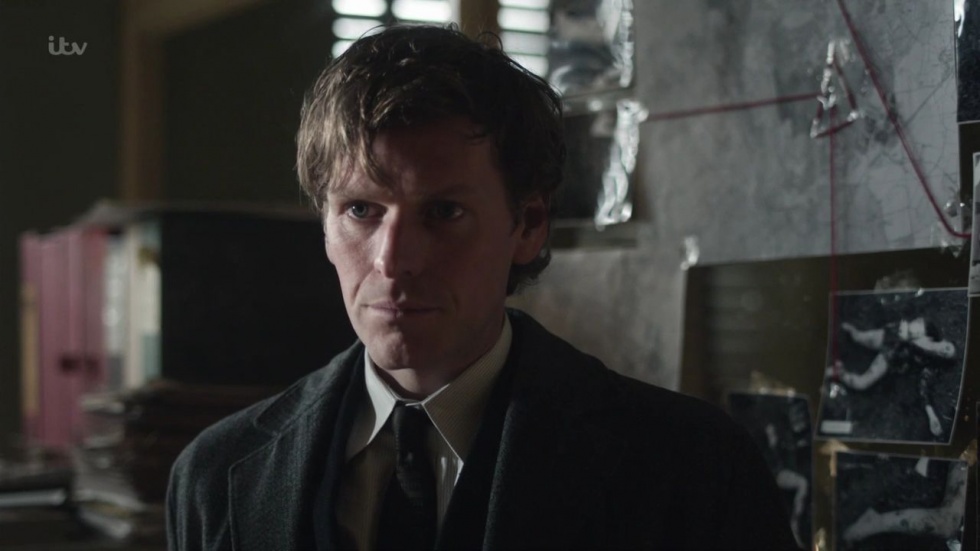 DAMIAN: We’ve seen flashes before of course, but series three saw a significant softening of Bright. Why has the barking and impatient Chief Superintendent suddenly mellowed?
DAMIAN: We’ve seen flashes before of course, but series three saw a significant softening of Bright. Why has the barking and impatient Chief Superintendent suddenly mellowed?
RUSS: As mentioned, Bright felt himself very much responsible for what happened to Endeavour and Thursday at the end of NEVERLAND, and is resolved to do better by his men. This was covered quite heavily in the excised Bright/Thursday scene, but we hoped there was enough contained in his welcome back to Endeavour, and the expression of his hopes for a better tomorrow, to point the way forward.
DAMIAN: Again, Bright makes reference to his wife in this film (she enjoys flower arranging) but when will we actually see her?
RUSS: It’s almost more interesting not to see her. But who knows?
DAMIAN: And what does Thursday have on his sandwiches on a Wednesday?
RUSS: That is for the moment a private matter between Fred and Win.
DAMIAN: There seemed to be few or at least very slight references to Easter so I’m wondering why you decided to set RIDE during that bank holiday weekend?
RUSS: There may have been more — again, almost two years on, I’m not sure what actually survived into the final cut. But Easter seemed to be very much in keeping with a theme of coming back to life. Spring. The earth renewed. Change. And a Bank Holiday is when most fairs tend to come to town.
 DAMIAN: Some of the scenes involving Monica and Dorothea were cut. What did we miss?
DAMIAN: Some of the scenes involving Monica and Dorothea were cut. What did we miss?
RUSS: Cripes – now I do have to rack my brain. Dorothea was more involved in the early drafts in setting up Bixby — and ran into Endeavour down at his cabin in the woods. She talked to him there about the fallout from Blenheim Vale and his movements over the intervening months. I suspect it bit the dust as it was another harking back to Series III. Monica… If I remember, there was a scene between them which left things… not entirely resolved. My original intent had been to plot the unravelling of the relationship across the rest of the series, but the feeling was that their story had been told, and had been brought – for better or worse – to a close by the events at the end of NEVERLAND.
Endeavour had cut himself off from Monica as a way to try to protect her from the forces that had put Thursday in hospital and him in prison. It called back to Thursday’s line from HOME, that ‘they come at you through what you care about.’
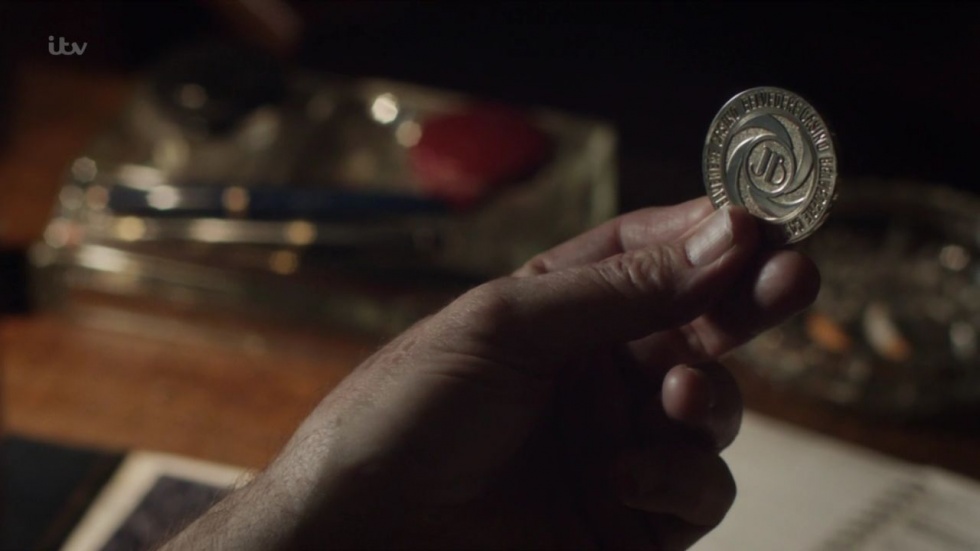 DAMIAN: Once more, this film is a maze of references in which the Morse scholar could easily lose themselves (Fitzgerald, Kipling, Twain and Orson Welles) but early on, we see the initials JB on a gambling chip which even has the familiar inside a gun barrel design and a fair few other allusions to 007 but it’s also interesting to note the comparisons between Joss Bixby and Lord Lucan who was renowned for his expensive lifestyle and passions including gambling, obsessive love and racing power boats (he also drove an Aston Martin and was apparently once considered for the role of James Bond). Were these deliberate references to Lucan?
DAMIAN: Once more, this film is a maze of references in which the Morse scholar could easily lose themselves (Fitzgerald, Kipling, Twain and Orson Welles) but early on, we see the initials JB on a gambling chip which even has the familiar inside a gun barrel design and a fair few other allusions to 007 but it’s also interesting to note the comparisons between Joss Bixby and Lord Lucan who was renowned for his expensive lifestyle and passions including gambling, obsessive love and racing power boats (he also drove an Aston Martin and was apparently once considered for the role of James Bond). Were these deliberate references to Lucan?
RUSS: The stage directions did include reference to a Lucan lookee-likee, and I think he might be there at the gambling tables. Much of the underlying inspiration for Series III drew on the Mayfair Set, of which he was a part.

 Mulling over the bow-tie and DJ world of the Mayfair Set (our own James Bradshaw played Charlie Benson in the ITV LUCAN drama) — and being rather taken by that milieu, it struck me that there were reasonable comparisons to be drawn between that keystone year in the decade and the excesses and wild abandon of an even earlier incarnation of that Set — the Bright Young Things of the Jazz Age. Certain emotional parallels. The giddy, alcohol & cocaine fuelled madness – as lived and described by Waugh, and Fitzgerald, among others – in some way a needful spasm after the bloodletting and carnage of the Great War. And I wondered if that Summer of Love was in its own way a similar high tide, albeit one far slower to arrive, after the wholesale slaughter of ’39-’45. A younger generation finally stepping out of the shadows of rationing and forelock-tugging and taking possession of their own moment.
Mulling over the bow-tie and DJ world of the Mayfair Set (our own James Bradshaw played Charlie Benson in the ITV LUCAN drama) — and being rather taken by that milieu, it struck me that there were reasonable comparisons to be drawn between that keystone year in the decade and the excesses and wild abandon of an even earlier incarnation of that Set — the Bright Young Things of the Jazz Age. Certain emotional parallels. The giddy, alcohol & cocaine fuelled madness – as lived and described by Waugh, and Fitzgerald, among others – in some way a needful spasm after the bloodletting and carnage of the Great War. And I wondered if that Summer of Love was in its own way a similar high tide, albeit one far slower to arrive, after the wholesale slaughter of ’39-’45. A younger generation finally stepping out of the shadows of rationing and forelock-tugging and taking possession of their own moment.
In any event, such was my in all likelihood muddle headed reasoning, and once the idea struck me, the rat was in the bottle. All else followed on from that.
Bixby was something of an amalgamation of several of the Mayfair Set — including John Aspinall, and drew on his alleged chemmy wheeze with Billy Hill, a notable figure in the London underworld for some forty years.
After Bixby’s death, there was a scene between Strange and Jakes which shed some light on the scam. A small, old fashioned mangle was discovered, which had been used to put a ‘bend’ on the picture cards — in order to make them easier to read — by those trained to do so — from across the table. This, it was suggested, was what Bixby and Harry Rose had been up to. But – again – it was excised due to running time.
In any case — Mister Evans does cut something of a dash in a tux. So… for that reason alone it was worth putting him amongst the highball crowd.
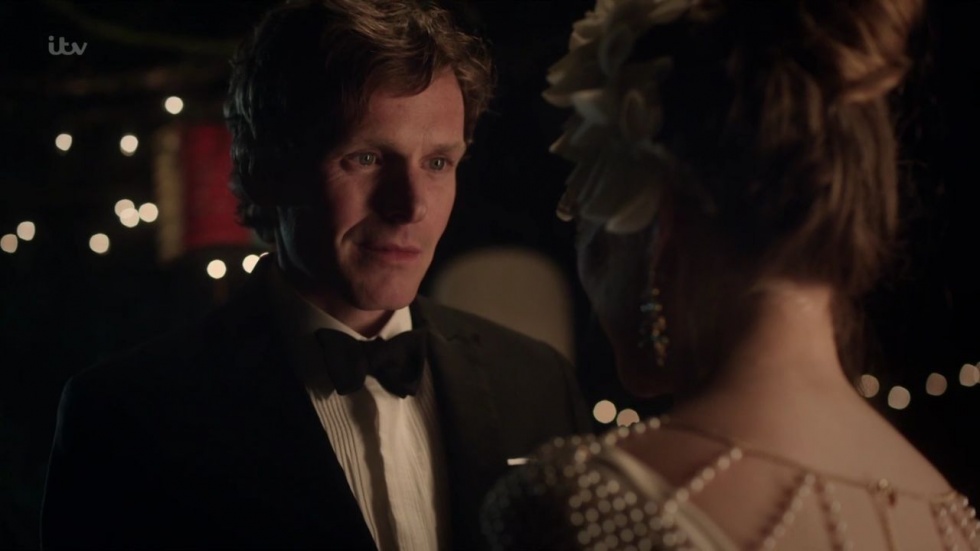 DAMIAN: There was a gentleman wearing an eyepatch playing at a gambling table during one of Bixby’s parties, was that supposed to be Emilio Largo from THUNDERBALL?
DAMIAN: There was a gentleman wearing an eyepatch playing at a gambling table during one of Bixby’s parties, was that supposed to be Emilio Largo from THUNDERBALL?
RUSS: No — like the nod to Lucan, it was a nod to another member of the Mayfair Set. Many of the various legends surrounding that particular crew provided jumping off points for SERIES III — particularly FILMS 1 and 3. Perhaps we’ll discuss it more when we get to PREY.
DAMIAN: You mentioned that you had a relative who witnessed the crashing of the Bluebird in one of our interviews last year, could you tell us a little bit more about that please?
RUSS: His name was Tom Henshaw – and he was my maternal grandmother’s nephew. What does that make him — second cousin once removed? He worked for a motor company – the name of which, decades later, escapes me – I believe in an engineering capacity.
DAMIAN: Did you ever see that lovely little 1988 TV Movie ACROSS THE LAKE with Anthony Hopkins as Campbell?
RUSS: It was a terrific piece of work. Cracking script, beautifully shot, and Sir Anthony Hopkins was simply wonderful.
DAMIAN: I loved the little nods to later films in RIDE such as Endeavour winning a tiger for Kay at the fun fair rifle range and perhaps most audacious of all – The Great Zambezi coughing up the bullet after the magician’s gun trick! These are almost Hitchcockian in their mischievous allusions to future plot points and storylines aren’t they?
RUSS: Well spotted. Yes — the funfair scene was originally a much bigger pissing contest between Endeavour and Bruce — sadly cut down to make schedule. And the bullet cough… I guess we’ll cover that in more detail when we get to CODA.

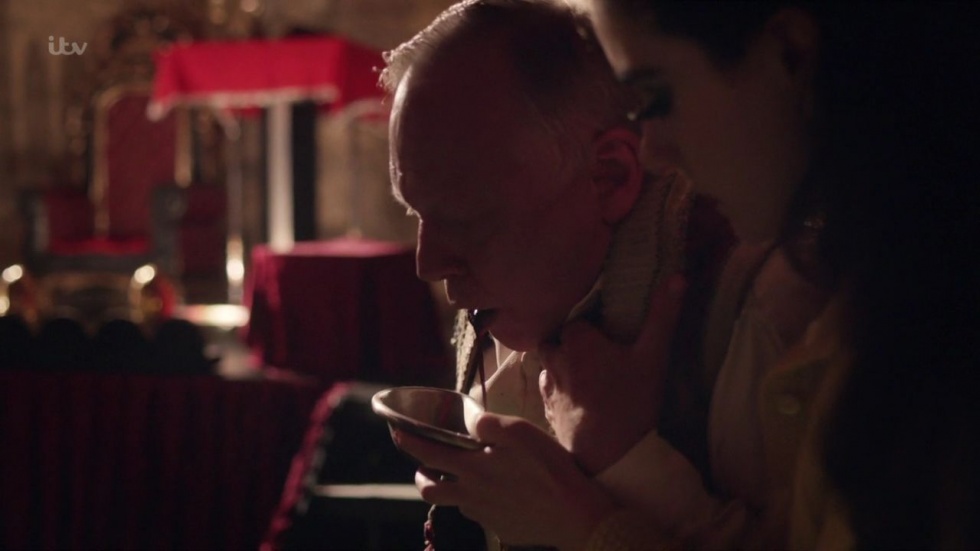 DAMIAN: So series four begins tonight. What can’t you tell us about the first film – GAME?
DAMIAN: So series four begins tonight. What can’t you tell us about the first film – GAME?
RUSS: I can’t tell you who did it.
DAMIAN: I see. Well, you mentioned last year that as part of your preparation for series three, you created “mood boards” or collages for each film. Can you at least tell us which photographs, newspaper reports, brand designs, album sleeves, portraits or stills from movies that you may have drawn inspiration this time?
RUSS: This year… moving with the times, I put together an A/V Keynote presentation for ITV on the Macbook – and ran that through their TV. Looking back — I think the underlying theme of SERIES IV was quietly asserting itself. For ‘67 Volume 2, we wanted to explore Mister Wilson’s ‘White Heat of technology’ a bit. And that’s certainly to the fore in GAME.
DAMIAN: Will it be “classic” or “unconventional” ENDEAVOUR?
RUSS: Classically unconventional… or perhaps unconventionally classic.
DAMIAN: Anthony Donn and Roland Marshall from DECEIVED BY FLIGHT made appearances in RIDE, will we be seeing more characters from the original series pop up?
RUSS: If not characters from the original series, then certainly characters related to characters. More, I can’t say. You will, I’m sure, recognise an actor whose path crossed with DCI Morse 30 years ago, in tonight’s film.
DAMIAN: Do any of the films happen to take place on a Wednesday?
RUSS: They might.
DAMIAN: And when did you say we would meet Mrs. Bright?
RUSS: I don’t believe I did. She has a very busy social calendar.
DAMIAN: So, Russell Lewis, I’m going to cast you away on a deserted island with only eight episodes of INSPECTOR MORSE to take with you (Desert Island DVDs or Desert Island Dexter perhaps?). Can you give us your first two episodes and tell us why you’ve chosen them please?
RUSS: Oh… That’s a tough one. In no particular order… I’ve got a very soft spot for DRIVEN TO DISTRACTION. A marvellous swansong from the man who opened the batting and set the template for all that followed — the late, great Anthony Minghella. As Morse stories go, I think DTD was refreshingly unconventional. Kind of slasher movie opening — done with great restraint. Almost like the reverse of the extended pull out of Bob Rusk’s flat in FRENZY — back down the stairs, out of the front door into the street. Unusually limited set of suspects on which to draw — was it going to be Boynton… or wasn’t it? And the finale was inspired. Corking performances from Mr. Malahide, Christopher Fulford, and David Ryall which kept everyone guessing until the very end.
And… GREEKS BEARING GIFTS. A seemingly complex case underpinned by perhaps one of the most tragically human motives in the whole casebook. Deeply affecting. Stellar cast — Mister Martin Jarvis, of course; and Jan Harvey, as Randall & Friday Rees. The much missed James Hazeldine as Digby Tuckerman; Richard Pearson almost stealing the whole film with his exquisitely realised Jerome Hogg.
What I love is how the whole thing mushrooms — from the death of a chef from a Greek restaurant, to College and a reconstructed trireme, via TV’s golden couple. It does what some of the very best Morse stories do – touching on both town and gown, the high and the low, and providing a bridge from Lewis’ domestic world to Morse’s professional life.
The denouement is properly heart-in-mouth, edge of your seat stuff. Brilliantly realised by Adrian Shergold. Hilarious, all these years later, to remember it caused a question to be raised in the House of Commons. MPs unable to distinguish between fact and fiction. Perish the thought.
DAMIAN: Thank you very much indeed for the intelligent answers. Until next Sunday then…
RUSS: Until then. Thank you.
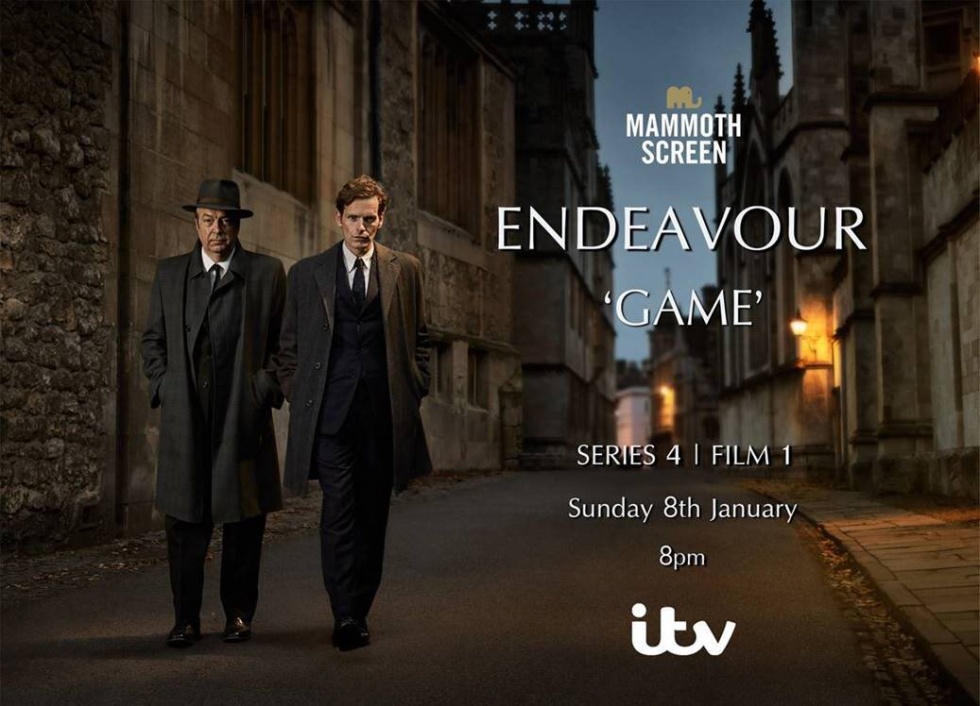 THE ENDEAVOUR ARCHIVES / 3529 / RIDE
THE ENDEAVOUR ARCHIVES / 3529 / RIDE
Interview copyright © Damian Michael Barcroft 2017
All the interviews and articles on this website are original and exclusive and I would please ask that the copyright be respected. Therefore, please do not use quotes or any other information contained here without permission. Thank you.
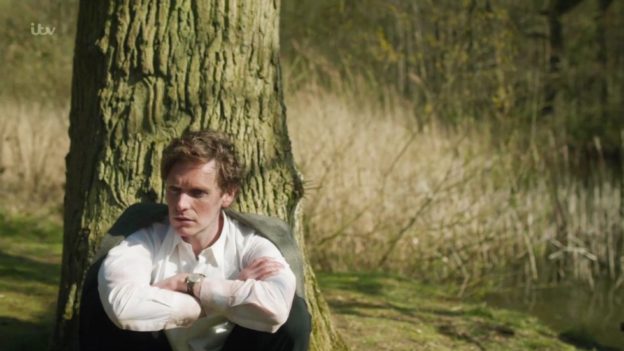
Great to see a new set of interviews and a dissection of Season 3. This will make my Sunday morning over the next few weeks.
I’ll need to go back and re-watch “Ride” to remind myself of all of the allusions to popular culture. I’d be interested to know if Russell Lewis includes so many references because they mean something to him personally, or if he believes Endeavour sits in the same universe as these other icons, or if in some way he sees these hidden motifs as cryptic references that allude to Morse’s love of crosswords?
I just re-watched “Ride” again last night and came across this blog this morning when looking for others who appreciate what a fantastically clever piece of writing it (and all of Endeavour) is. Thanks so much for interviewing Russell Lewis and writing this, and I hope you’ll be following Endeavour into the (apparently longer) fifth series!